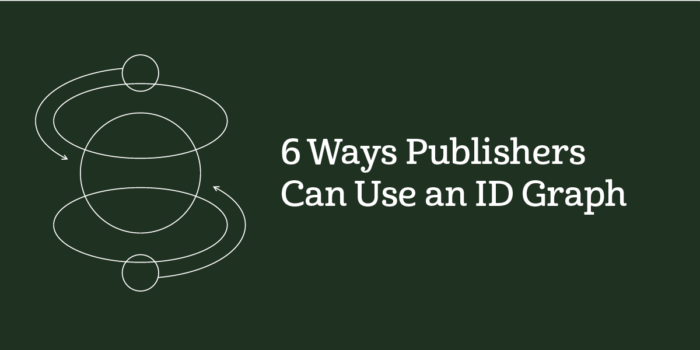
Customers want a personalized marketing experience, but brands can have trouble truly understanding each customer. With so many people switching from laptops to smartphones to tablets to real-world touchpoints, collating those identities becomes necessary for optimizing marketing.
Recognizing individual users across multiple devices and touchpoints online and offline allows marketers to create a bespoke experience for each user. But how can all that information be streamlined and organized into a clear view of the individual. An identity graph is how it’s done.
Collating both online and offline data across multiple devices, an ID graph gives marketers a clean, well-rounded understanding of each individual and provides a cohesive customer identity, which is crucial for marketers.
What Is an Identity (ID) Graph?
In an age when personalization is top of mind for many marketers, an ID graph is an ideal solution. It’s a technology that allows marketers to gain a unified customer view by stitching together data from multiple channels to create a cohesive view of individuals that goes beyond just likes, dislikes or IP addresses.
The goal is to create a panoramic view of the individual that allows marketers to provide personalized marketing to each customer or prospect. The better you know people, the better you can engage them, and an ID graph is a tool that makes that possible.
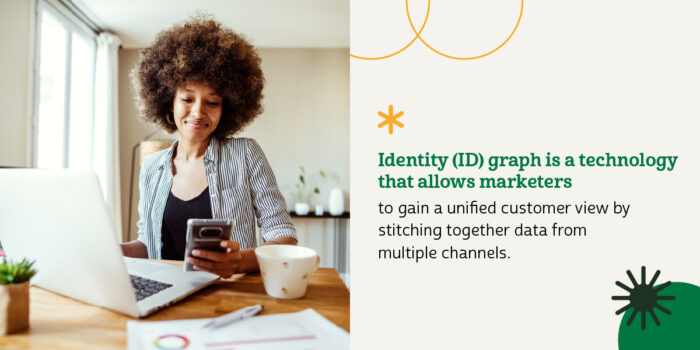
An individual’s multiple identifiers — addresses, device IDs, loyalty card numbers, browser cookies, etc. — are spread over various browsers, devices, and online and offline touchpoints. An identity graph intelligently collects all this data, as well as any behavioral data like purchase history. It then binds it to the individual to present a unified identity that falls under one of two categories:
- Authenticated: As the descriptor suggests, authenticated users are those that use authenticated identities, such as those that require logging in. Authenticated profiles are a collection of first-party data that gives a more accurate description of a user.
- Non-authenticated: In contrast to authenticated profiles, non-authenticated profiles are those created with temporary identities, such as device IDs or browser cookies, making them less reliable in the long run.
Authenticated profiles, unlike non-authenticated ones, provide a device graph of clusters of attributes that are mapped down to the ID level or household level. This cluster can include devices, behaviors, location or affinities or a whole host of other attributes. An identity graph allows you to better understand your customer because it’s a flexible and intelligent way to gather consumer data and streamline it into a neat package.
Why Do ID Graphs Matter?
If the goal is to create a unique and personalized customer experience, then truly understanding the individual customer is necessary. The more fragmented your identity data is, the harder it will be to successfully reach customers and increase engagement and conversion.

With identity resolution, marketers can be consistent in their marketing strategies and won’t need to rely as much on old-fashioned trial-and-error marketing campaigns since a more accurate summary will be available.
If a person shops from both a smartphone and a laptop, identity resolution, which uses cross-device identification, recognizes one individual rather than two different people. Cross-device identification is a useful marketing strategy since it localizes into one identity the often vast and varied browsing and shopping patterns of any given individual.
This collection of data builds into the coveted single customer view, which — as the name suggests — unifies all data about a customer into one unified view. By unifying all this information, marketers get a detailed overview of how and what customers are buying, browsing, reading, etc. on any platform.
The information is not only collated, but it also collects both online and offline data and is updated in real-time, so you’re never working with stagnant information. Therefore, marketers can more accurately see who is engaging with their brand the most, who needs to be encouraged to engage more and who has stopped engaging altogether.
6 Ways Publishers Can Use an ID Graph
The single customer view afforded by ID graphs makes them an incredibly useful tool for publishers and marketers. The cohesive panorama of a customer’s habits provided by a proper ID graph has six main benefits:
- Curate better customer experience
- Offer effective promotions
- Focus on engaged clients
- Reconnect with those who lost interest
- Identify behavioral changes in real-time
- Optimize performance
Smarter marketing comes from developing impressive ID graphs as well as using them properly to reap the possible benefits, as well as managing privacy consent.
1. Curate Better Customer Experience
With a more detailed identity graph, you inevitably have the opportunity to have more personalized marketing strategies. People-based targeting unifies an individual’s data, and that data is the key to developing specialized marketing strategies that are more likely to increase return on investment.
By having a fully rounded view of an individual and focusing on their likes, dislikes and general browsing habits, marketers can provide more personalized content, including recommendations and targeted advertisements. Accurate identity graphs also help more customer inquiries be solved faster.
And because visitors inevitably will use multiple platforms to access their information at any given time, the cross-device identification ensures that you don’t lose track of the customers or misidentify them when they change devices. Cross-device identification also allows marketers to see how and when customers interact on their multiple devices and build marketing strategies that target how a user interacts specifically with any given device.
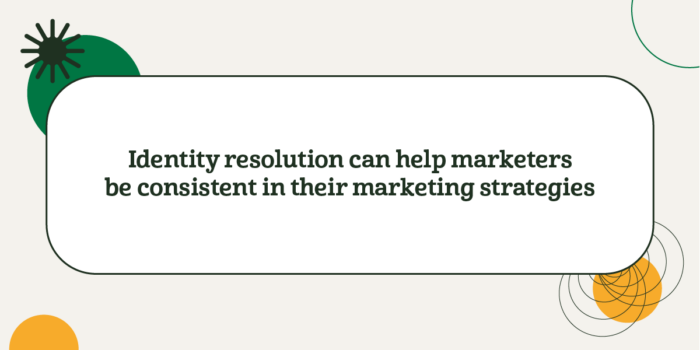
A running update on these patterns also lets marketers better strategize for future interactions. All of which results in customers being happier and more likely to engage since they feel like they are being catered to personally.
2. Offer Effective Promotions
With an accurate graph, marketers can take advantage of the opportunity to personalize content and offer up promotions that are likely to be far more effective.
Using smart marketing opens up many doors for upselling or cross-selling products and promotions that customers are more likely to take advantage of. Identity resolution eschews the need for generic marketing and invites targeted marketing that will bring in a better return on investment.
In addition to being curated for individual customers, the targeted promotions can also be context-aware to reach customers at times they are more likely to be receptive to them, as well as on the ideal platform.
There’s also room for a little trial and error in terms of testing how certain content performs across platforms and using that information to move forward and avoid campaigns that don’t work without risking too much money. Detailed tracking of the success of different campaigns also gives marketers better insight on how to alter campaigns to make them even more effective in the future.
And identity graphs do all this in a way that is authentic and relatable rather than detached, which is a useful trait regardless of whether you’re trying to keep customers engaged, lure back lost customers or improve engagement from certain customers.

3. Focus on Engaged Clients
One of the many perks of identity resolution is seeing which customers are consistently engaged, which are losing interest and which have ceased to engage altogether.
Keeping the engaged clients happy is crucial, and with identity graphs, you get a better view of how a customer is interacting with your brand. This allows you to tailor content to each of them specifically, but it also allows you to reward loyalty by offering specialized promotions for certain clients.
Once the most engaged clients are identified, you can create a marketing plan curated to them based on their habits. This is money well invested with a better chance for a great return because you’re not spending energy and money on clients who have shown that they are not at all interested.
Personalized experiences, like in-app recommendations and exclusive coupons, continue the goal of making customers feel like they are unique and thus inspiring them to trust your brand to know them as well as they know themselves.
Collating offline and online data is another way ID graphs are great for marketers since it ensures that you’re getting a single, holistic view of each customer.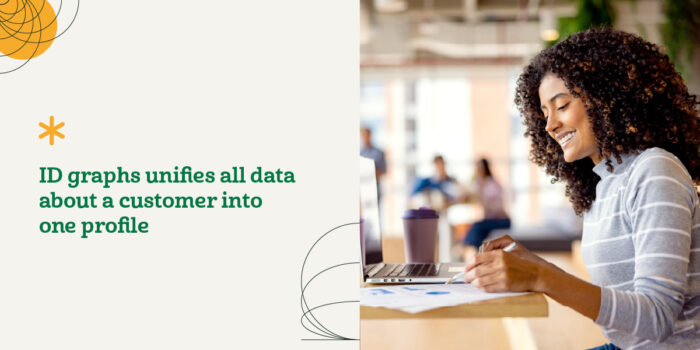
4. Reconnect With Those Who Lost Interest
While you are less likely to invest time and money into generalized content and focus more on personalized content for engaged customers, that same information can be used to encourage former customers to return — or even keep them from leaving if they’re on the fence.
The more detailed your identity graph is, the more information you have about your customers and their habits. That information includes seeing how much or how little they interact with your brand, so if you notice a customer has started to lose interest, you can curate content to encourage them to re-engage with your brand.
Similarly, if you’re looking to win back customers who seem to have lost interest, their identity graph will show you what is most interesting to them. You can use that information to strategize content and advertisements that are likely to attract them.
5. Identity Behavioral Changes in Real-Time
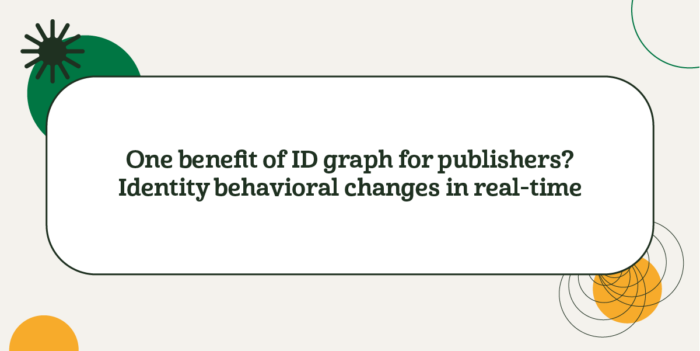
The digital world is notorious for constantly changing and evolving, which means that marketers and publishers have to constantly be on the ball when it comes to the best way to keep customers happy. Real-time data collection is a necessity for online marketing and is another benefit provided by identity graphs.

The beauty of ID graphs is that they are constantly collecting data and updating, so you’re never targeting customers using old information. New information is automatically sewn into the existing ID graph, so the picture you have is always relevant. There’s no need to target customers with personalized content that stopped being relevant to them days or weeks ago. Content is constantly being updated to reflect the customers’ needs and wants in the present.
Real-time engagement includes both offline and online information, and it is ideal for ensuring customer concerns are resolved as soon as possible. It’s also the best way to meet any other customer requirements without making the customer wait. And it all happens automatically, across all devices.
Real-time information also allows marketers to be flexible when it comes to their content or advertisement by updating their strategy to reflect the change in data.
6. Optimize Performance
Marketers can use the collated information of an identity graph to monitor the success rate of a variety of content. They can then use this information to kick up content that is performing well and scale back content that performs poorly.
The ability to analyze a variety of content at once and use that information to better personalize content helps brands reduce wasted space while also keeping customers from getting sick and tired of seeing the same content over and over again. The frequency of this content is also tracked, and the results will influence how marketers decide to restrategize.
Customers are used to the ease of having the world at their fingertips and of their devices better predicting their wants and needs. With ID graphs, marketers can take advantage of this trend and use it to their advantage to both ensure better performance as well as lessen the chance of wasting resources.

Identifying and engaging customers in a way that’s meaningful and authentic also instill faith in your brand and gives it credibility. If customers know they can rely on you to provide them with exactly what they need, they are more likely to stay engaged.
Find Your People With Lotame
At Lotame, we want you to find your people, which is why we offer Panorama Identity, our identity framework that ensures clients can engage respectfully and meaningfully with consumers across all screens. Broaden your customer view and extend data connectivity with our Panorama Identity solutions. Powering Lotame’s end-to-end data collaboration platform Spherical, Panorama Identity preserves and extends addressability across the global open web and beyond.
Get in touch and request a demo today.
How are marketers and publishers adjusting their customer acquisition strategies in light of nonstop industry change? We surveyed over 1,400 decision-makers to better understand identity’s role in their cookieless future, what they’re adding and removing from the next-gen tech stack, and where they plan to invest today and in the future. Get the report here.
